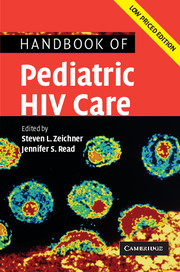Book contents
- Frontmatter
- Contents
- List of contributors
- List of abbreviations
- Foreword
- Preface
- Part I Scientific basis of pediatric HIV care
- Part II General issues in the care of pediatric HIV patients
- 3 Diagnosis of HIV infection in children
- 4 Prevention of mother-to-child transmission of HIV
- 5 Routine pediatric care
- 6 Emergency evaluation and care
- 7 Adherence to antiretroviral therapy in children and youth
- 8 Adolescents and HIV
- 9 Growth, nutrition, and metabolism
- 10 Neurobehavioral function and assessment of children and adolescents with HIV infection
- Part III Antiretroviral therapy
- Part IV Clinical manifestations of HIV infection in children
- Part V Infectious problems in pediatric HIV disease
- Part VI Medical, social, and legal issues
- Appendix 1 Formulary of antiretroviral agents
- Appendix 2 National Institutes of Health sponsored clinical trials for pediatric HIV disease
- Appendix 3 Selected HIV-related internet resources
- Appendix 4 Selected legal resources for HIV-infected children
- Index
- References
9 - Growth, nutrition, and metabolism
Published online by Cambridge University Press: 23 December 2009
- Frontmatter
- Contents
- List of contributors
- List of abbreviations
- Foreword
- Preface
- Part I Scientific basis of pediatric HIV care
- Part II General issues in the care of pediatric HIV patients
- 3 Diagnosis of HIV infection in children
- 4 Prevention of mother-to-child transmission of HIV
- 5 Routine pediatric care
- 6 Emergency evaluation and care
- 7 Adherence to antiretroviral therapy in children and youth
- 8 Adolescents and HIV
- 9 Growth, nutrition, and metabolism
- 10 Neurobehavioral function and assessment of children and adolescents with HIV infection
- Part III Antiretroviral therapy
- Part IV Clinical manifestations of HIV infection in children
- Part V Infectious problems in pediatric HIV disease
- Part VI Medical, social, and legal issues
- Appendix 1 Formulary of antiretroviral agents
- Appendix 2 National Institutes of Health sponsored clinical trials for pediatric HIV disease
- Appendix 3 Selected HIV-related internet resources
- Appendix 4 Selected legal resources for HIV-infected children
- Index
- References
Summary
In recent years, growth, nutrition and metabolism of HIV-infected children have received increased attention for several reasons. It has been recognized for the past decade that HIV-infected children generally do not grow as well as their uninfected counterparts, but more recent evidence suggests that this is often true even in the face of adequate virologic control. Given also that growth is a predictor of survival, there has been closer scrutiny of nutritional and metabolic factors that can contribute to poor growth. Additionally, potentially serious metabolic complications of HIV infection and/or antiretroviral therapies overlap with nutritional aspects of the infection and have prompted attention to the pathophysiology of malnutrition in these children.
The current state of knowledge regarding the complex interrelationships of nutrition, HIV disease, antiretroviral therapy, and growth is reviewed in this chapter. Recommendations for nutritional monitoring and support are discussed, as are therapies for certain recognized causes of malnutrition in HIV-infected children. Briefly described are the complications and recommended treatments for fat redistribution, hyperlipidemia, insulin resistance, osteonecrosis, and mitochondrial toxicity. Finally, nutritional issues most germane to resource-poor settings are highlighted.
Definitions: malnutrition, growth failure
Pediatric HIV disease may lead to multiple nutritional deficiencies. Deficiencies of adequate macronutrients (protein or calories) and/or micronutrients (vitamins, minerals) to maintain optimal health status is referred to as undernutrition or, more commonly, malnutrition. Many definitions for growth failure or failure to thrive (FTT) exist.
- Type
- Chapter
- Information
- Handbook of Pediatric HIV Care , pp. 273 - 308Publisher: Cambridge University PressPrint publication year: 2006



